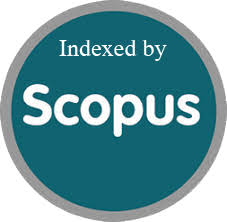The Impact of Polylactic Acid on Sustainable Asphalt Mixture
Abstract
Recently, sulfur waste SW has been utilized as a potential calcium carbonate CaCO3 mineral filler replacement. This study evaluated the effects of polylactic acid (PLA) polymer on asphalt mixtures containing CaCO3 filler and asphalt mixtures containing SW as alternative fillers. A 40-50 mixture of paving-grade asphalt with a PLA ratio of 1.5% by weight of asphalt was blended. Performance tests, including Marshall stability (MS), Marshall quotient (MQ), indirect tensile strength (ITS), and deformation strength (SD) in the Kim test, were performed on asphalt mixtures. Test results showed that the (MS) and (MQ) mixtures containing filler SW increased by 1.4% and 23.1%, respectively, while the values of the (ITS) and (TSR) rates decreased (13.1% and 2.8%), respectively, and (SD) were very close. The modified asphalt mixtures were better than the unmodified mixtures in terms of MS, MQ, ITS, TSR, and SD. The values increased by 37%, 27.9%, 29.4%, 4.35%, and 7.18%, respectively, incomprison with the unmodified asphalt mixtures containing sulfur waste. Likewise, the values increased by 50.6%, 56.8%, 32.1%, 2.66%, and 6.11%, respectively, in comparison with the unmodified asphalt mixtures containing CaCO3. Generally, the modified mixtures were better than the unmodified mixtures. Sulfur waste can be used as a sustainable mineral filler for paving applications without and with 1.5% PLA polymer, as it is low-cost and available.
References
- G. Valdes-Vidal, A. Calabi-Floody, and E. Sanchez-Alonso, Performance evaluation of warm mix asphalt involving natural zeolite and reclaimed asphalt pavement (RAP) for sustainable pavement construction, Constr. Build. Mater., vol. 174, pp. 576585, 2018, doi: https://doi.org/10.1016/j.conbuildmat.2018.04.149.
- A. Azarhoosh, F. Moghaddas Nejad, and A. Khodaii, Evaluation of the effect of nano-TiO2 on the adhesion between aggregate and asphalt binder in hot mix asphalt, Eur. J. Environ. Civ. Eng., vol. 22, no. 8, pp. 946961, 2018, doi: https://doi.org/10.1080/19648189.2016.1229227.
- A. E. Alvarez, E. Ovalles, and S. Caro, Assessment of the effect of mineral filler on asphaltaggregate interfaces based on thermodynamic properties, Constr. Build. Mater., vol. 28, no. 1, pp. 599606, 2012, doi: https://doi.org/10.1016/j.conbuildmat.2011.08.089.
- A. I. Al-Hadidy, Laboratory evaluation of sulfur waste asphalt mixtures containing SBS and waste polypropylene polymers, Int. J. Pavement Res. Technol., vol. 17, no. 2, pp. 503517, 2024.
- A. I. Al-Hadidy, Sustainable recycling of sulfur waste through utilization in asphalt paving applications, Int. J. Pavement Res. Technol., vol. 16, no. 2, pp. 474486, 2023.
- A. J. Taylor, N. H. Tran, R. May, D. H. Timm, M. M. Robbins, and B. Powell, Laboratory evaluation of sulfur-modified warm mix, J. Assoc. Asph. Paving Technol., vol. 79, 2010.
- A.-H. AI, A. F. Jasim, and A. M. Rashed, Mechanistic analysis and durability of thiophene paving mixtures, J. Mater. Civ. Eng., vol. 34, no. 7, p. 6022002, 2022, doi: https://doi.org/10.1061/(ASCE)MT.1943-5533.0004285.
- Asphalt Institute, Mix Design Method For Asphalt Concrete and Other Hot-Mix Design. MS-2, 1984.
- ASTM, Standard test method for ductility of asphalt materials. D113, American Society for Testing and Materials, West Conshohocken, PA, USA,. 2017.
- ASTM, Standard test method for penetration of bituminous materials. D5/D5M, ASTM International, West Conshohocken, PA,. 2020.
- ASTM, Standard test method for relative density (specific gravity) and absorption of coarse aggregate. C127, ASTM International, West Conshohocken, PA, 2015.
- ASTM, Standard test method for relative density (specific gravity) and absorption of fine aggregate. C128, ASTM International, West Conshohocken, PA, 2015.
- ASTM, Standard test method for resistance to degradation of small-size coarse aggregate by abrasion and impact in the Los Angeles machine, C131, ASTM International, West Conshohocken, PA. 2006..
- ASTM, Standard test method for softening point of bitumen (ring-and-ball apparatus). D36/D36M, ASTM International, West Conshohocken, PA,. 2020.
- ASTM, Standard test methods for uncompacted void content of fine aggregate (as influenced by particle shape, surface texture, and grading). C1252, ASTM International West Conshohocken, PA, USA, 2017.
- ASTM, Test Method for Soundness of Aggregates by Use of Sodium Sulfate or Magnesium Sulfate, C88, ASTM International: West Conshohocken, PA, USA., 2013.
- ASTM, Standard specification for hot-mixed, hot-laid bituminous paving mixtures, D3515, 2001.
- ASTM, Standard test method for determination of cracking tolerance index of asphalt mixture using the indirect tensile cracking test at intermediate temperature D8225,. ASTM International West Conshohocken, PA, 2019.
- ASTM, Standard test method for determining the percentage of fractured particles in coarse aggregate. D5821, ASTM International West Conshohocken, PA, USA, 2017.
- ASTM, Standard test method for effect of moisture on asphalt concrete paving mixtures, D4867/D4867M., 2022.
- ASTM, Standard Test Method for Elastic Recovery of Asphalt Materials by Ductilometer, D6084, 2021.
- ASTM, Standard Test Method for Indirect Tensile (IDT) Strength of Asphalt Mixtures D6931, 2017.
- ASTM, Standard Test Method for Marshall Stability and Flow of Asphalt Mixtures D6927-15, ASTM Int. West Conshohocken, PA, USA, 2015.
- ASTM. International, Standard Test Method for Evaluating the Compatibility of Polymers and Asphalt Binders. ASTM International Standard D6230-22, 2022.
- D. N. Little and J. C. Petersen, Unique effects of hydrated lime filler on the performance-related properties of asphalt cements: Physical and chemical interactions revisited, J. Mater. Civ. Eng., vol. 17, no. 2, pp. 207218, 2005, doi: https://doi.org/10.1061/(ASCE)0899-1561(2005)17:2(207).
- F. Yin, R. West, B. Powell, and C. J. DuBois, Short-Term Performance Characterization and Fatigue Damage Prediction of Asphalt Mixtures Containing Polymer-Modified Binders and Recycled Plastics, Transp. Res. Rec., p. 03611981221143119, 2023, doi: https://doi.org/10.1177/03611981221143119.
- G. Mancini, ltalia P, Method Prep. stable bitumenpolymer Mix. EP 0, vol. 458386, p. A1, 1991.
- G. Polacco, S. Filippi, F. Merusi, and G. Stastna, A review of the fundamentals of polymer-modified asphalts: Asphalt/polymer interactions and principles of compatibility, Adv. Colloid Interface Sci., vol. 224, pp. 72112, 2015.
- H. T. Mahmood, A. I. Al-Hadidy, and D. Zejiao, Evaluating the Mechanical Performance of Hot and Warm Asphalt Mixtures Utilizing Sulfur Waste as an Alternative Filler, Al-Rafidain Eng. J., vol. 29, no. 1, pp. 111, 2024, doi: 10.33899/rengj.2023.143569.1289.
- I. a. T. i. K. Ministry of Land, Guideline for construction of asphalt concrete pavement., 2017.
- J. Choudhary, B. Kumar, and A. Gupta, Utilization of solid waste materials as alternative fillers in asphalt mixes: A review, Constr. Build. Mater., vol. 234, p. 117271, 2020, doi: https://doi.org/10.1016/j.conbuildmat.2019.117271.
- K. Yan, H. Xu, and H. Zhang, Effect of mineral filler on properties of warm asphalt mastic containing Sasobit, Constr. Build. Mater., vol. 48, pp. 622627, 2013, doi: https://doi.org/10.1016/j.conbuildmat.2013.07.085.
- M. A. Al-Mohammed and A. I. Al-Hadidy, Comparative Performance of Unmodified and SBS-Modified Asphalt Mixtures Made with Blowdown (CarSul) and Calcium Carbonate as Mineral Fillers, J. Mater. Civ. Eng., vol. 36, no. 6, pp. 024-004833, 2024, doi: https://doi.org/10.1061/JMCEE7.MTENG-17369.
- M. A. Al-Mohammed and A. I. Al-Hadidy, Durability and Rutting Resistance of SBS-Modified Asphalt Mixtures Containing Blowdown as a Sustainable Filler, Al-Rafidain Eng. J., vol. 28, no. 2, pp. 4857, 2023, doi: 10.33899/rengj.2023.142194.1273.
- M. A. Franesqui, J. Yepes, C. Garca-Gonzlez, and J. Gallego, Sustainable low-temperature asphalt mixtures with marginal porous volcanic aggregates and crumb rubber modified bitumen, J. Clean. Prod., vol. 207, pp. 4456, 2019, doi: https://doi.org/10.1016/j.jclepro.2018.09.219.
- M. A. Gul, R. Khan, Kaffayatullah Islam, Md Kamrul Shalabi, Faisal I Ozer, Hasan Hajj, and A. Bhasin, Evaluation of various factorsaffecting mix design of sulfur-extended asphalt mixes, Constr. Build. Mater., vol. 290, p. 123199, 2021, doi: https://doi.org/10.1016/j.conbuildmat.2021.123199.
- M. Arabani, S. A. Tahami, and M. Taghipoor, Laboratory investigation of hot mix asphalt containing waste materials, Road Mater. Pavement Des., vol. 18, no. 3, pp. 713729, 2017, doi: https://doi.org/10.1080/14680629.2016.1189349.
- M. Zaumanis, L. D. Poulikakos, and M. N. Partl, Performance-based design of asphalt mixtures and review of key parameters, Mater. Des., vol. 141, pp. 185201, 2018, doi: https://doi.org/10.1016/j.matdes.2017.12.035.
- N. A. H. AL-Saffar, The Effect of Filler Type and Content on Hot Asphalt Concrete Mixtures Properties., Al-Rafadain Eng. J., vol. 21, no. 6, 2013, doi: https://doi.org/10.33899/rengj.2013.82394.
- N. Jailani, A. Nazrul, H. Ibrahim, A. Rahim, N. Abdul, and N. Izzi, Chemical and physical properties of poly ( lactic ) acid modified bitumen, Ain Shams Eng. J., 2021, doi: 10.1016/j.asej.2021.03.004.
- N. Kim, J. Park, J. S. Choi, S. Kim, and K. W. Kim, Correlation of Deformation Strength (SD) and Tensile Strength of Asphalt Mixtures, J. Korean Asph. Inst., vol. 1, no. 1, pp. 6269, 2011.
- N. T. Trang, T. N. Hung, P. H. Khang, B. X. Cy, and B. N. Kien, Research on the effects of sulfur on characteristics of sulfur bituminous binder (SBB) and hot mix asphalt-sulfur (HMAS), Transp. Commun. Sci. J.(72), vol. 1, 2021, doi: https://doi.org/10.47869/tcsj.72.1.5.
- N.-A. A. B. Taib et al., A review on poly lactic acid (PLA) as a biodegradable polymer, Polym. Bull., vol. 80, no. 2, pp. 11791213, 2023.
- National Center for Construction Laboratories (NCCL), Materials and construction works specification, Ministry of Housing and Construction and Public Works. Directorate of Research and Technical Affairs, Baghdad-Iraq. 2018.
- P. Ahmedzade, M. Tigdemir, and S. F. Kalyoncuoglu, Laboratory investigation of the properties of asphalt concrete mixtures modified with TOPSBS, Constr. Build. Mater., vol. 21, no. 3, pp. 626633, 2007, doi: https://doi.org/10.1016/j.conbuildmat.2005.12.003.
- P. properties of PLA, www.matbase.com/material/polymers/agrobased/polylactic-acid-pla/properties, 2019.
- P. S. Chowdhury, S. L. A. Noojilla, and M. A. Reddy, Evaluation of fatigue characteristics of asphalt mixtures using Cracking Tolerance index (CTIndex), Constr. Build. Mater., vol. 342, p. 128030, 2022, doi: https://doi.org/10.1016/j.conbuildmat.2022.128030.
- Q. Xu, H. Chen, and J. A. Prozzi, Performance of fiber reinforced asphalt concrete under environmental temperature and water effects, Constr. Build. Mater., vol. 24, no. 10, pp. 20032010, 2010, doi: https://doi.org/10.1016/j.conbuildmat.2010.03.012.
- R. Ullah, I. Hafeez, W. Haroon, and S. Haider, Evaluating the effect of plastomer modified asphalt mixture on high/low temperature performance, Mehran Univ. Res. J. Eng. Technol., vol. 40, no. 3, pp. 680691, 2021, doi: https://doi.org/10.22581/muet1982.2103.20.
- S. A. Khalid and A. I. Al-Hadidy, Comparative Rheological and Mechanical Characteristics of Different Warm-Mix Asphalt Additives Under Aging Conditions, Al-Rafidain Eng. J. (AREJ)-Mosul/Iraq, vol. 25, no. 1, pp. 4250, 2020, doi: 10.33899/rengj.2020.126842.1025.
- S. F. Ali, AymanKabir, C. Al-Badr, Basel Alfalah, Ahmad Xie, Zhaoxing Decarlo, and Y. Elshaer, Mohamed Mehta, Laboratory performance of dense graded asphalt mixtures prepared using highly polymer modified binders containing corn oil as softening agent, Constr. Build. Mater., vol. 345, p. 128336, 2022, doi: https://doi.org/10.1016/j.conbuildmat.2022.128336.
- S. K. Rasheed and A. Ai, Tensile Strength And Moisture Sensitivity of Sulfur Waste in Asphalt Mixtures As An Eco-friendly Filler, J. Duhok Univ., vol. 25, no. 1, pp. 164173, 2022, doi: 10.26682/sjuod.2022.25.1.18.
- SCRB, General Specification for Roads and Bridges, 2007.
- T. Harman, J. Youtcheff, and J. Bukowski, An alternative asphalt binder, sulfur-extended asphalt (SEA), United States. Federal Highway Administration, 2012.
- Xometry, Types of 3D Printer Filamentshttps://www.xometry.com/resources/3D-Printer/types-of-3d-Printer-filament/, 2022.
- Y. Huang, R. N. Bird, and O. Heidrich, A review of the use of recycled solid waste materials in asphalt pavements, Resour. Conserv. Recycl., vol. 52, no. 1, pp. 5873, 2007, doi: https://doi.org/10.1016/j.resconrec.2007.02.002.
- Y. S. Doh, K. K. Yun, S. N. Amirkhanian, and K. W. Kim, Framework for developing a static strength test for measuring deformation resistance of asphalt concrete mixtures, Constr. Build. Mater., vol. 21, no. 12, pp. 20472058, 2007, doi: https://doi.org/10.1016/j.conbuildmat.2006.06.032.








